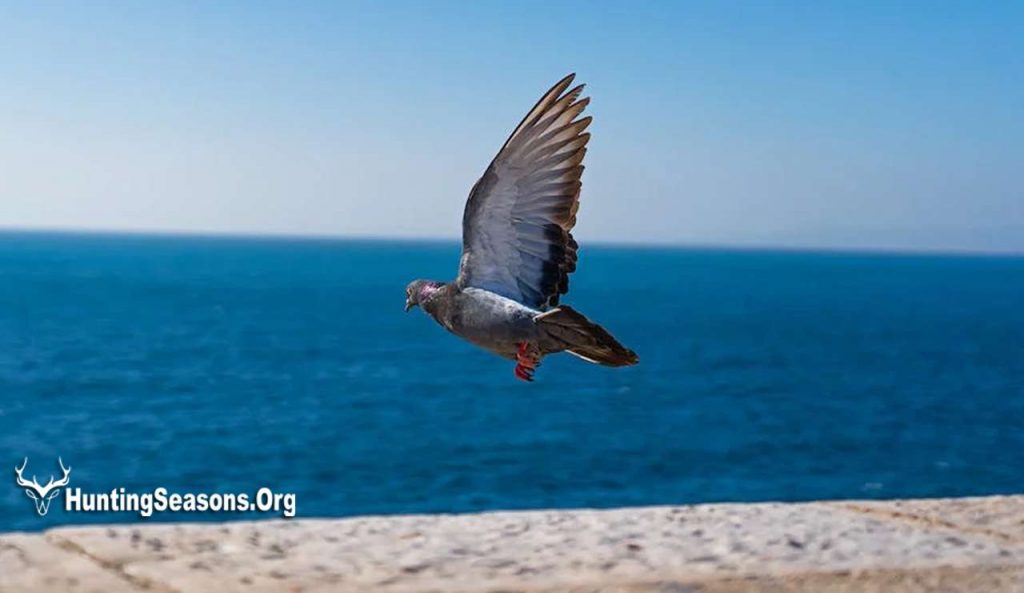Pigeons are able to achieve impressively fast flight speeds that may surprise many people. When racing or migrating, pigeons can sustain rapid airspeeds for long durations that allow them to cover hundreds of miles in a day. Their specialized wings and streamlined bodies are adapted for achieving maximum velocity and efficiency in the air. Read on to learn more details about exactly how fast pigeons can fly using various speed metrics and benchmark comparisons.
Cruising Speed
The cruising speed is the average airspeed a pigeon can maintain over long distances during routine, non-urgent flights:
- Pigeons generally cruise at speeds between 40-50 miles per hour (64-80 kilometers per hour).
- This is their comfortable, energy-efficient pace for extended flights up to a few hundred miles.
- At cruising velocity, a pigeon flaps its wings about 4-5 times per second.
- The cruising speed balances speed with physiological economy to optimize range and duration.
Pigeons will spend the majority of their flight time cruising at their aerobically ideal speed to minimize fatigue and burn efficient fuel mixtures. This allows them to fly long distances overhead or commuting to food sources.
Top Airspeed
When traveling at top sustained speed, pigeons can reach significantly faster velocities:
- The maximum airspeed of a pigeon in level flight is around 75 miles per hour.
- Elite racing pigeons can maintain speeds approaching 90 mph for parts of a race.
- Descending at an angle, pigeons can exceed 100 mph while minimizing wing-flapping.
- These fast speeds can only be sustained for short bursts before anaerobic exertion sets in.
Pigeons rely on these energetically expensive high speeds to escape from predators or blitz to a destination over short intervals measured in minutes rather than hours. The metabolic demands limit their use to emergency maneuvers.
Racing Speed
Pigeon races provide real-world examples of the flight velocities pigeons can attain over set courses:
- Champion racing pigeons average speeds of 50-60 mph over 100 mile races.
- The top racing pigeons can achieve average race speeds of 70+ mph on 500 mile courses.
- One 545 mile race was won with an average speed of 83.8 mph maintained the entire trip.
- The current speed record for a long distance race of 600+ miles is 92.5 mph.
Specially bred and trained racing pigeons demonstrate the impressive cruising speeds these birds can sustain when highly motivated. Their performance reflects innate physiological capabilities optimized through selective breeding and conditioning.

Comparisons with Other Birds
The flying speeds achieved by pigeons become even more impressive when compared to the capabilities of other bird species:
- The fastest powered flight by a bird ever recorded was a Peregrine Falcon diving at 242 mph.
- Swifts have been documented at maximum speeds around 111 mph.
- Typical songbird flight only ranges between 20-40 mph.
- Geese flying in migration max out around 50 mph.
- Even ducks pushed to top airspeeds only reach around 60 mph.
| Type of Birds | Highest Speed | Unit |
|---|---|---|
| Peregrine falcon | 241.71 | Miles Per hour |
| Golden eagle | 149.12-198.83 | Miles Per hour |
| White-throated needletail | 105.01 | Miles Per hour |
| Eurasian hobby | 99.41 | Miles Per hour |
| Frigatebird | 95.06 | Miles Per hour |
| Spur-winged goose | 88.23 | Miles Per hour |
| Red-breasted merganser | 80.15 | Miles Per hour |
| Rock dove (pigeon) | 92.52 | Miles Per hour |
| Grey-headed albatross | 78.91 | Miles Per hour |
| Anna's hummingbird | 61.06 | Miles Per hour |
With own Species
| Pigeon Family | Pigeon Speed KM | Pigeon Speed Miles |
|---|---|---|
| Homing Pigeons | 97 km per hr | 60 miles per hour |
| Racing Pigeons | 150 km per hr | 93 miles per hour |
| Wood Pigeons | 124 km per hr | 77.6 miles per hour |
| Clay Pigeons | 68 km per hr | 42 miles per hour |
Pigeons are definitively among the speediest long-distance flying birds in terms of velocity and endurance. Their high innate muscle ratios and streamlining allow them to cruise faster and farther than most avian species.
Contributing Factors
Several factors influence the potential flight speed of a pigeon:
- Age – younger pigeons fly slower until reaching peak maturity and flight muscle development.
- Fitness – leaner birds with greater flight muscle ratios attain higher speeds.
- Body size – smaller pigeons tend to be slightly faster than larger breeds.
- Weather – headwinds and turbulence inhibit speed, while tailwinds enhance it.
- Trip Purpose – pigeons driven by instinct fly faster than routine foraging flights.
- Comportment – determined focused birds fly faster than distracted or uncertain ones.
The most important determinants of pigeon airspeed are age, physical conditioning, and motivation level for a particular journey. When all factors align, pigeons can fly up to 90 mph over hundreds of miles.
Flight Abilities Underpin Survival
The pigeon’s ability to fly fast serves key survival and reproductive purposes:
- Escaping predators like hawks by rapidly out-flying them.
- Quickly traversing long distances between scarce food and water sources.
- Efficiently commuting to and from centralized nesting or roosting sites.
- Rapidly migrating to reach optimal seasonal habitats.
- Returning to home lofts and mates as fast as possible.
- Competing for territory airspace claims by resident pigeons.
- Swiftly conveying messages over remote communication networks.
Over hundreds of generations, the pigeon’s specialized abilities as a swift long-distance flier evolved as adaptations to enhance survival rates and success.
So next time you see a pigeon gracefully coasting through the sky, remember that hidden within is a powerful biological flying machine able to rocket up to 90 mph! The pigeon’s speed and agility help explain how they came to populate nearly every corner of the globe so successfully alongside humans.
FAQ
How fast can a wood pigeon fly?
A Wood pigeon can fly up to 77.6 miles per hour.
Are pigeons the fastest bird?
Pigeons are among one the fastest bird but does not top the list. Peregrine falcon takes the first position with a flying speed of 241.71 Miles per hour; following it Golden eagle takes the second position with a flying speed of 149.12-198.83 miles per hour.
Sources
Journal of Experimental Biology
The Cornell Lab of Ornithology
- Virginia Hunting Seasons 2024 Latest Dates & Regulations - July 22, 2024
- Georgia Hunting Season 2024-2025 [Updated Schedule!] - July 19, 2024
- 2024 Tennessee Hunting Seasons New Dates & Regulations! - July 11, 2024





